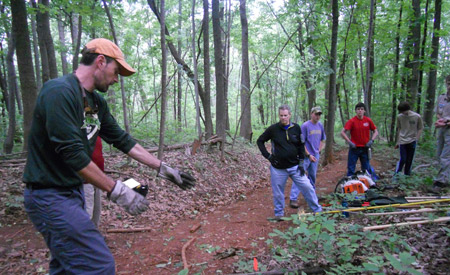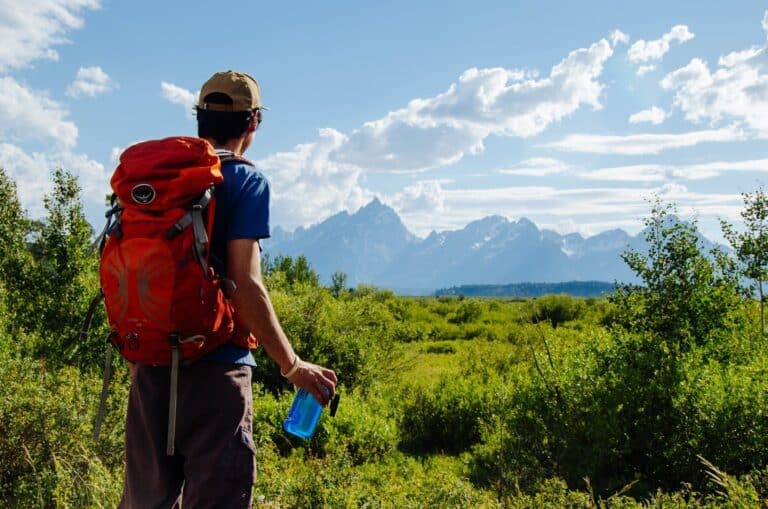A new trail is wending its way up the northwest aspect of Carter Mountain in Charlottesville, the product of a unique collaboration between the Boy Scouts, the Thomas Jefferson Foundation and the local mountain bike club.
A crew of 10 scouts and cyclists set out the morning of May 25 to shape the new Carter Mountain trail, based on a route flagged several months earlier by Graham Haynie, a boy scout with local Troop 37, and members of the Charlottesville Area Mountain Bike Club, or CAMBC. Located within the Saunders-Monticello trail system on the southern edge of Charlottesville, the new route will connect the Hartman-Orchard Trail with the Mountain Trail, via approximately seven switchbacks ascending 500 feet.
“It’s going to be a great hiking trail; it’s going to be a challenging mountain bike trail on the uphill,” CAMBC President Dave Stackhouse said while marking the upper section of the soon-to-be trail with pin flags. He added that the trail will likely be more popular for descending on a bike, with enough switchbacks to prompt cyclists to squeeze the brakes as they negotiate the turns.
For Haynie, 15, building the new trail represents the service component of his progress toward becoming an Eagle Scout. For CAMBC, however, the project affords an opportunity to pass along the club’s experience and principles on building sustainable trails that follow the contours of the terrain, while minimizing erosion. And as the first time CAMBC has worked with the Thomas Jefferson Foundation, the new trail could set the precedent for potential future improvements to a trail system heavily used – and cherished — by Charlottesville residents.
“If we do a really good job here and we show the Thomas Jefferson Foundation we can make beautiful, sustainable trails that work for everybody, then maybe we can do more of this,” Sam Lindblom, a CAMBC board member, said. “We’re partially excited about this because we’re hoping that it opens a bunch of doors for us.”
The new trail modifies the initial route established earlier in the year by Haynie and the Thomas Jefferson Foundation after the scout inquired about possible service projects that could benefit hikers and bikers. Stackhouse, Lindblom and other CAMBC members noticed the new trail after it was blown in, which basically followed the fall line steeply up the slope of the mountain, and saw room for improvement.
“We met him out here and talked about what he wanted to do,” Stackhouse said. “We started mentoring him on what a sustainable trail was.” Using a clinometer, the CAMBC members returned to the trail with Haynie and plotted a switch-backed route with a milder grade, while still connecting to the original entrance and exit. “The slope is really hard and it would erode,” Haynie said of his initial trail’s route. “We decided not to because it was too hard of a trail.”

On the recent Saturday morning the group built the new trail, the CAMBC members loaded the scouts up with leaf blowers, Rogue hoes, McCleods and other trail-building implements, before setting off up the mountain. Along the way, they pointed out where runoff was washing trenches into established trails, and users had established parallel paths to avoid muddier sections.
At the site, Haynie divided the group into several teams, with one covering up the original trail. Others cut and cleared the corridor of the new trail, behind the pin flags set by Stackhouse, and followed by a leaf blower illuminating the actual path. Bringing up the rear were those doing the slow, strenuous work of actually cutting the trail tread into the slope, using Rogue hoes to dig out roots and rocks, and the McCleods to smooth and grade it.
Along the way, the CAMBC members advised the scouts on the angles to dig that allow for comfortable travel, while still facilitating water sheeting evenly across the trail tread. “You’re trying to cut out a wedge or triangle out of the slope so that we have an appropriate trail to walk on,” Lindblom said to the scouts swinging hoes. “You don’t want a trench because a trench holds water.”
Building a trail in the manner prescribed by CAMBC was a new experience for the scouts of Troop 37, but one the boys can draw from when several undertake a planned trail-building project in New Mexico later in the year. The CAMBC members, meanwhile, were happy to harness the energy of the scouts for a project that would normally take much longer to develop, and pass along their trail ethic.
“It’s great to have that exuberance of youth and do it in a day,” Stackhouse said. “We can come back and improve it as we go, knowing the basic foundation we’re laying here is going to be a good one.”








